For our debut podcast, we interviewed Lee Brockington, Senior Interpreter for the Belle W. Baruch Foundation, whose tireless enthusiasm for the story of Hobcaw Barony extends from guided tours on location to numerous articles and presentations on the subject and her book, Plantation Between the Waters: A Brief History of Hobcaw Barony. Ms. Brockington continually serves as a guide and mentor for this project and not a week goes by where we don’t tap her inexhaustible reservoir of knowledge of the people and places of the area as we develop the interactive, virtual tour.
Ms. Brockington originally contributed “The Caines Brothers: An Untold Legacy” as part of the 2007 program guide for the Winyah Bay Heritage Festival, a celebration of “Art, Decoys, Hunting, Fishing and Conservation” benefiting the Georgetown County Historical Society. In an earlier post, A Caines Family Tradition, we introduced the name so synonymous with Hobcaw Barony’s hunting heritage, and posted an excerpt from an interview conducted with Roy and Jerry Caines, descendants of the Caines brothers.
Ms. Brockington’s article, republished with permission of the Winyah Bay Heritage Festival, provides an in depth look at a family history inextricably tied to place. Photos courtesy of the Georgetown County Digital Library.
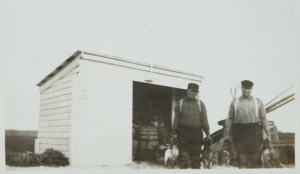
Two of the four Caines brothers in Bernard Baruch’s employ, Sawney and Hucks, stand near a shed at Hobcaw’s Clambank Landing as they prepare to clean ducks from the day’s kill. c. 1919
Smoke rises up through the chimney of the pre-Civil War cabin at Clambank, an isolated island amidst a 5000-acre salt marsh at Hobcaw Barony. The smell of strong coffee and sizzling beef steaks and pork chops causes men to tumble out from under quilts, stretch their cold, stiff bodies and check their pocket watches—4:30 am.
Sarah Caines has been cooking for duck hunters years now, feeding them and pushing them out the door so her husband, Richard, and his black staff could maneuver the men of the hunt club toward their duck blinds. Sarah cleans up, makes another pot of coffee and moves toward the buckboard wagon. Even though she knows the men will have easily gotten their 100-200 ducks by 9 a.m., she is ready to go back to her own house at Caines Village and check on her boys. She needs to get them fed and working on their chores, even though she knows their step-brother, Ball, awoke them before he headed out to do his gunning and deliver it to the Market Wharf along Georgetown’s waterfront.
Her boys are awake and disappointed that they missed the morning’s hunt. She tells Sawney, Pluty, Hucks and Bob that their day will come when they can not only go on the hunt, but serve as guides for some of the richest and most important men in America. The day is dawning as she moves up the Kings Highway on the way to her job at the sawmill commissary on the northern end of the barony. She smiles, thinking of what Hobcaw means to her family and to her sons’ futures.
Dominated by rivers, bay and ocean, Georgetown County celebrates its sporting heritage by honoring hunting and fishing guides, commercial and recreational uses of the area’s rich natural resources and individuals whose singular crafts and talents contribute to an important legacy. The Caines brothers created the earliest known hand-carved decoys for use in local waters, decoys that exhibit rare artistry and whose value has created legends about the brothers. The South Carolina Lowcountry is so rich with history that the stories do not have to be enlarged or exaggerated, nor do ghosts have to bring characters out of the past. Factual history tells of men whose life stories include millionaires, presidents and prime ministers and decoys now sold at auctions for tens of thousands of dollars.
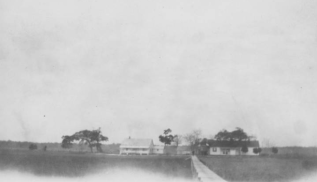
Set amidst the sprawling 5000-acre marsh at Hobcaw Barony, Clambank Landing featured a 19th century rice planter’s summer home and a 1905 hunt cabin built by new owner, Bernard Baruch. A wooden boat, built by the Caines brothers, stands beside a cistern, used to gather rainwater for either summer residents or hunters.
The Caines brothers grew up on land at Hobcaw Barony and were hired as hunting guides for Bernard M. Baruch, native South Carolinian and New York financier, on his shooting preserve during the early 20th century. But the Caines story begins much earlier according to Caines descendants. The first record of a Caines in SC was in 1737. In 1780, John Caines was born and he later married Ann Hucks. The record shows that he was the captain of a vessel, which sailed up the Pee Dee River in 1830 to Smith’s Mill. The widower married a second time to Violette Haselden and by 1879, John Caines had 18 grandchildren. His son Richard C. Caines settled on the shore of Winyah Bay at Hobcaw and saw three generations of his family live on what had been part of Michau Plantation.
They cultivated and harvested rice and worked as watermen, commercial fishermen and “gunners” from the mid-19th century until the turn of the 20th century. The Caines brothers gunned ducks for the markets of Charleston, Greenville and Raleigh throughout the late 1890s and during that same time, portions of North Inlet near their home was leased to paying individuals for hunting. In 1896, Hartwig Nathaniel Baruch, older brother of Bernard, held the lease and the No Trespassing sign from that year is still in the exhibit at Hobcaw House.
Kaminski cousins recommended the area to the Baruchs as a delightful place to hunt. In January of 1903, according to county newspaper records, “US Circuit Court Judge Simonton sentenced Edmund Alston ‘Ball’ Caines and Allen Hill, two of the champion duckhunters of the Georgetown sections, to a term of one week in jail for contempt of court.” They had both violated a previous court injunction restraining them from trespassing on the preserves of Alexander R. Chisholm and others. They received light punishment as a result of the fact that, “the court has looked into the rugged face of Caines on many occasions and warned him about shooting on the other people’s property, but Ball is too much of a hunter to stay off when he thinks there is a chance to bring down a bird.”
But by Dec. 29, 1911, Ball’s luck had changed. The court decided to jail Ball after he legally hunted in the marshes along the Bread and Butter Creek in North Inlet. Hobcaw’s rice fields and salt marshes totaled thousands of acres of fertile hunting ground. Purchased in 1905-07, the barony comprised 17,500 acres now belonging to Bernard M. Baruch of New York City. Baruch’s game warden, Jim Powell and his deerkeeper, watcher or woods rider, Floyd Brown, together testified that Ball was on high ground when he fired and retrieved ducks. According to the Bernard Baruch papers at Princeton University, the judgement was guilty and the sentence was eight months in jail in Georgetown, handed down by Judge J.C. Pritchard.
Herbert Hucks, Jr. remembered that his grandfather, Joseph Jenkins Hucks, a lawyer and judge, hunted with the Caines brothers and represented them in court. With respect and admiration, Ball Caines presented him with a pair of miniature decoys and named his second son Joseph Hucks Caines. Later when Judge Hucks was a hunting guest of Baruch’s at Hobcaw, Hucks guessed, “He forgot or forgave” that he had defended the Caines.
Ball (1849-1914) was the only one of the five brothers that did not accept employment as offered by Baruch. Baruch realized that the men were not only exceptional marksmen and cunning hunters, but the men held poachers and trespassers at bay. Shortly after 1905, “Sawney” (1859-1938), “Pluty” (1869-1911), “Hucks” (1876-1944), and Bob (1879-1923) were hired as Baruch guides and showed his guests, some of the most powerful men in America, how to hunt duck, turkey, hog and deer in the coastal plain of Carolina.
Prior to federal game laws in 1918, “ducks were like bees pouring out of a bottle,” blackening the sky and falling prey to market gunners. By using huge punt guns, commercial hunters brought down a brace of ducks all at once. The ducks and other wild game were taken to the Market Wharf in Georgetown for export to the northeast. It was not unusual for fine hotels and restaurants to advertise “Carolina Plantation Duck” on their menus.
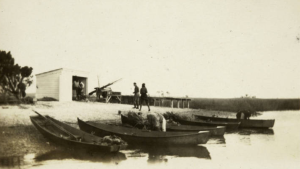
Duck hunters at Hobcaw fired both from blinds and from boats, or bateaux, seen here in North Inlet at Hobcaw Barony.
Many hunters from the north came as guests of post-Civil War plantation owners who were hosting paid hunts or leasing land. Many more formed their own hunt clubs or purchased these former rice plantations. The majority of the hunters were wealthy northerners, but some clubs were founded by southerners as well. The Caines brothers first guided for hunt clubs and took on as a passenger President Grover Cleveland, who was variously a guest of the Annandale Gun Club, the Santee Gun Club or Confederate General Edward P. Alexander, owner of most of North Island and South Island. In 1894, the president was guided by Sawney Caines to an ideal location in North Inlet where a duck blind was located, a part of Hobcaw that is still called “The President’s Stand.” Sawney maneuvered the wooden boat and pulled it up on the oyster bank. He stepped out and walked lightly and quickly over the pluff mud, looking over his shoulder as he did. Behind him he saw the 300-lb president of the United States sinking down to his knees in the mud. Sawney had to pull the president out of his hip boots and plop him down in the boat. Cleveland thought all the while it was hilarious and laughed right through Sawney getting his boots back, cleaning him up a bit and allowing him to get “medicined up.” Sawney, however, saw nothing amusing in the incident and for years to come, when asked to tell the story to visitors, never cracked a smile. It was always a serious matter to him.
The Caines were much loved by guests, whether preparing to hunt ducks at 4 a.m. or to begin the farcical “snipe hunt” at midnight with a first time visitor. Hucks was Baruch’s favorite guide and great raconteur, telling his stories around a barbecue pit or at an oyster roast after a long day in the field. Hucks like to pontificate on the advantages of Prohibition (1918-1933), one of which was the opportunity for him to make profits from his bootlegging.
Baruch greatly admired his skills in the woods and on the water. He wrote, “Hucks could call a duck so well with his mouth or with a caller that neither the hunter nor the duck could distinguish the call for that of a real duck. When I asked Hucks the secret of his success as a duck man, he would say, ‘Mr. Bernie, this business is like everything else — you just gotta know.’” They knew Hobcaw well and all five are laid to rest with family members in a cemetery located on the barony, not far from the bay itself.

George Shubrick, a descendant of Hobcaw slaves, served as a boatman at Hobcaw and was an expert on finding downed ducks during the hunt. c. 1910.
During the plantation era the rice fields attracted millions of ducks, which overwintered after harvest until early spring each year. J. Motte Alson wrote of hunting prior to the Civil War in his autobiography, Rice Planter and A Sportsman. His slave paddled noiselessly through the rice fields beyond the swamps of ash, tupelo, gum and cypress. Their boat was made of cypress, 13 feet long and 2 ½ feet wide, double-headed, light and watertight. He remembers that a gentleman on the Pee Dee, about 1840, killed 100 ducks by only two discharges from a double barreled shotgun. Alston said he never knew of another such abundant place for game as the Georgetown County rivers.
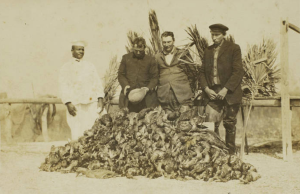
A circa 1910 postcard, produced for guests at Hobcaw Barony, features chef Charlie McCants, Sr. and hunting guides Bob, Hucks and Sawney Caines, all in the employ of Bernard Baruch. Before federal game limits were enacted in 1918, “100 duck days” were typical at Hobcaw.
Bernard Baruch said that he had enjoyed the finest duck shooting to be had in the world. He had gunned game in every region of the US, Czechoslovakia, Scotland and Great Britain, and Hobcaw Barony put those places to shame. Islands in the bay, rice fields, ponds, swamps, woodlands, salt marshes and a wide ocean beach all combined to provide a perfect 17,500-acre hunting retreat. The use of decoys was not as necessary as it seemed to be over the Chesapeake or Delaware Bays or on Long Island. Hunters of the early and mid-19th century do not appear to have needed decoys in the Winyah Bay region. William Elliott, writing Carolina Sportsman, in 1846, states that “the rice-fatted wild duck of Carolina was God’s greatest gift to hunters.” By the early 20th century, a decline in ducks corresponded with the increase in hunters and the first federal game limits were enacted in 1918 although it took another ten years to successfully enforce the laws. At that time, game warden was the nation’s most dangerous job as each man you stood down was armed.
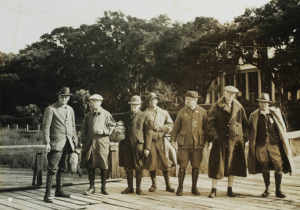
Bernard Baruch, second from right, entertained presidents, prime ministers and premiers between 1905 and 1956. As there was no bridge from Georgetown to the Waccamaw Neck until 1935, Hobcaw’s guests, pictured on the dock c. 1931 arrived by boat across Winyah Bay.
Seasonal duck hunters began to bring their factory made decoys with them each winter. A blessing for Baruch was that the Caines brothers, from necessity, had created their own decoys for gunning and after 1905, began to make more working decoys for their new boss, branding those with “BMB” on the bottom. Carved from a single piece of cypress or gum, Caines decoys were flat-bottomed, had long necks and raised wings. The wings have led collectors to speculate that the Caines may have borrowed the Delaware designs that they saw on the local waters, but the decoys they created were mostly influenced by their own creative impulses. All are oversized, yet there are four distinct styles of Caines decoys, leading others to believe that all four brothers did contribute to the design and not just the construction. Some say Hucks carved either the majority or at least carved the fine features of the head, neck and wings on mallards and black ducks. There are some pintails, and several blue winged teals. Some are hollow and some are the classic “snakey-neck” decoys. The eyes were often made with hat pins and many decoys went home with Baruch guests as souvenirs. All the decoys bobbed nicely in the tidal waters and were oversized “so the ducks could see ‘em from a long way off,” said Theodore “Bud” Caines, son of Sawney.
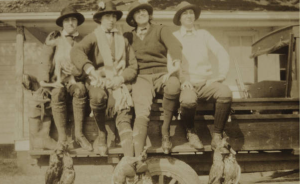
Belle Baruch, far right, with three guests have returned to headquarters at the hunt cabin at Clambank with a few pairs of ducks on display. c. 1910
While hundreds were created, it is believed that fewer than 50 decoys still exist. In the 1960s and 70s, according to Dick McIntyre, there were few who had ever heard of a Caines decoy and fewer still that had ever seen one. Until the 1980s, South Carolina-carved decoys were not even noted in the books. In 1987, two Charleston men reportedly paid $25 per decoy for 24 found in a Murrells Inlet antiques store. One resold at the Southeastern Wildlife Exposition auction one year later for $35,000 and in 1992, one is said to have sold at an auction of $158,000.
The market value of the decoys is recognized, but the value to the study of local history is unmeasured. The Caines brothers’ legacy is one often untold, overshadowed by men of wealth and position. Watermen, hunters and commercial fishermen are the people who usually know the woods and the waters best, but whose words are rarely in the history books. Their heritage speaks to the generations South Carolinians who have called the lowcountry their home.
Lee Brockington is a Senior Interpreter for the Belle W. Baruch Foundation. In 2006, Ms. Brockington published the book Plantation Between the Waters: A Brief History of Hobcaw Barony.

Pingback: Guest Post: Politics and Plantations in the Lowcountry-Understanding the “Second Yankee Invasion” (Part Three) | Making History Together
Pingback: Guest Post: Politics and Plantations in the Lowcountry – Understanding the “Second Yankee Invasion” (Part Three) | Making History Together